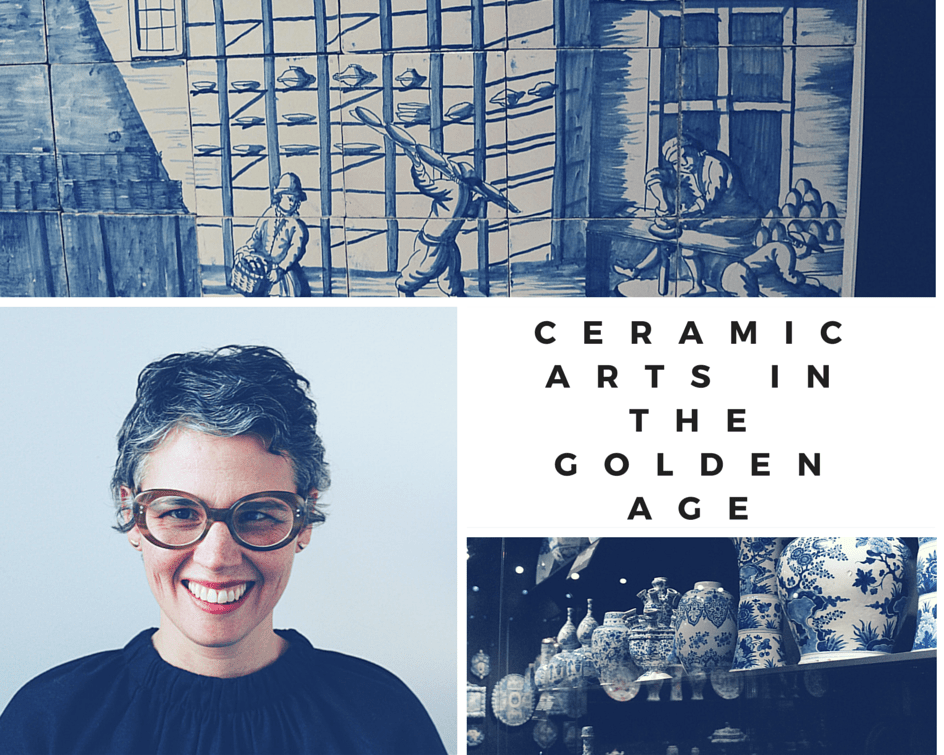This content has been archived. It may no longer be relevant
This week Thinking Museum is proud to announce a new programme ‘Ceramic Arts in the Golden Age‘ to add our growing list of in-depth tours. Conservator Katrina Posner has designed a special tour focusing on the wonderful ceramics collection in the Rijksmuseum. We caught up with Katrina to find out more:
Can you tell us a little bit about yourself and your background?
I grew up in Los Angeles and journeyed to the other side of the country for college, where I studied Art History and wrote my senior thesis on the American artist, Agnes Martin. After college I joined the mass-migration to San Francisco, where I apprenticed to a paper conservator by day and took chemistry and studio art classes in the evenings. After four years of living the good life in San Francisco, I packed up and moved to Buffalo, New York to begin my studies in art conservation. I decided to specialise in three-dimensional artworks, or as it is known in the US, objects conservation. After two years in Buffalo and a year treating objects from the fantastic collection of Egyptian art at the Brooklyn Museum in New York City, I found myself back in Los Angeles with a Graduate Internship in the Decorative Arts and Sculpture Conservation department at the Getty Museum. I eventually became a permanent member of that department where I was responsible, among other tasks, for the care and maintenance of the Getty’s collection of modern outdoor sculpture. In 2013, my family and I decided to shake things up and we moved to Amsterdam. I’ve since taken a step away from the ‘bench’ and have been exploring different ways to talk about our shared cultural heritage.
How did you come up with the idea for the new programme on ceramics? What was your inspiration?
Part of my recent explorations have been an attempt to consider the history of objects through the lens of my education and professional experience: art history and conservation together. My impetus was the field of Technical Art History – where the ‘how’ of an object’s genesis is explored alongside the ‘why’ of its contemporary context. This field invites art history, conservation science and the examination methodologies of art conservation to the same table, and through all of these facets we, as modern scholars, can really explore the internal and external components of an object.
OK, so why ceramics? I think clay is a very interesting medium for this kind of focus.
. It is one of the four natural elements and it exists all over the earth, right there in the ground. And, when it is combined with fire – another natural element – we get a hard-bodied vessel, plate, sculpture, building material. The possibilities are, and have been, endless. The Rijksmuseum’s ceramic arts collection contains examples from a wide range of time periods, cultures and aesthetics. And, the ceramic objects are nestled in among all the other, sometimes louder, media. Considering them closely is an opportunity to spend time with some very beautiful gems.
What can visitors expect from the new programme? Who is the programme aimed at?
Visitors will take a journey through ceramics of the past 1,000 years. We will look at porcelain from China and then European porcelain from the beginning of the 18th century, we will follow the trail of faience, or majolica, through the Middle East, into Southern Europe and then Northward to the Netherlands. We will examine how developments, both on the other sides of oceans and the other sides of feudal territories, complimented and encouraged each other.
Because the tour is specialised and somewhat focused, it is for visitors who are looking to go deeper into the context of the ceramics of the Golden Age (and its preceding eras). It can be a natural compliment to the time that a visitor had previously spent at the Rijksmuseum, or for the visitor who intends to look at the larger collection at a different time.
What is your favourite object in the new programme and why does it appeal to you? What makes you keep coming back to it?
I am very fond of the
Monkey who sits in the case with the other life-sized porcelain animals made by the Meissen Porcelain Manufactory. The figure is so playful and focused and present. I am partial to these animals because they were made at the tail end of a completely manic drive to crack the code of porcelain in Europe. They are examples of a technical
tour de force that are equal parts stunning and ridiculous.
How does your work as a conservator influence your work as a museum docent?
I’ve always said that it is hard for me to walk through a museum’s galleries and not look for damage. It is, unfortunately, wired into my approach to art – how is this object doing, how has it fared these five centuries since it was made, are we taking good care of it so that future generations will be able to marvel at its artistry? But when I push this sometimes distracting focus to one side and let in appreciation and wonder, I find these all make a good team. I have had the great privilege of being able to touch many works of art. I have looked inside the cavities of bronze sculptures with my own eyes and a flashlight, with a borescope, with x-rays. I have spent quiet hours with a terracotta bust, encountering the hands of the artist through the fingerprints left behind in the hardened clay. I have marveled at an Egyptian alabaster vessel from 1400 B.C.E. Its walls so even, its surface so smooth. I know how to look, how to be careful, how to let objects tell their stories, and I look forward to sharing some of these experiences in the galleries.
You can find out more about ‘Ceramic Arts in the Golden Age’
here.
